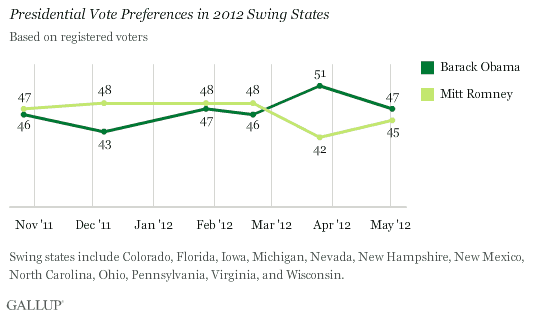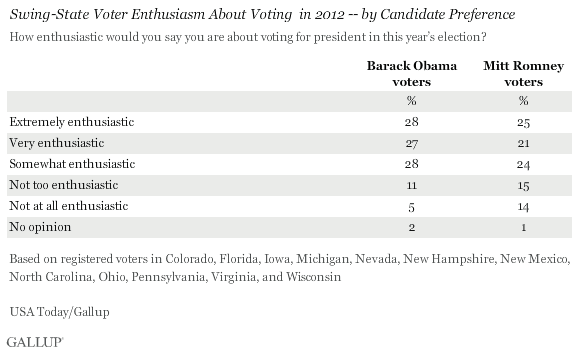PRINCETON, NJ -- In the first USA Today/Gallup swing-state poll conducted since Mitt Romney became the presumptive Republican nominee, Romney and President Barack Obama are nearly tied -- 45% vs. 47%, respectively -- among registered voters in the 12 battleground states that make up the poll.

The presumptive Republican nominee is better positioned today than he was in March, when USA Today/Gallup found Obama leading by nine percentage points among swing-state voters. Romney now roughly matches his standing earlier in the year, before he secured the Republican nomination.
The latest results are from the sixth USA Today/Gallup Swing States poll. Interviewing was conducted as part of Gallup Daily tracking April 26-May 2 with 951 registered voters in 12 states where the presidential race is expected to be closely contested: Colorado, Florida, Iowa, Michigan, Nevada, New Hampshire, New Mexico, North Carolina, Ohio, Pennsylvania, Virginia, and Wisconsin.
Intensity and Enthusiasm Favor Obama
While Obama edges out Romney by two points in the overall preferences of swing-state registered voters, he has a four-point advantage with respect to solid supporters: 36% of swing-state voters say they are certain they will vote for Obama in November, while 32% are certain they will vote for Romney. Each candidate's remaining supporters -- the 11% who favor Obama and the 13% favoring Romney -- say there is a chance they could change their mind between now and the election. An additional 7% of voters are undecided, meaning a total of 31% of swing-state voters are not firmly committed at this time.
Obama's swing-state prospects also look a bit brighter than Romney's on the basis of voter enthusiasm. More than half of Obama's supporters, 55%, are extremely or very enthusiastic about voting in this year's presidential election, up from 49% saying this in March. By contrast, 46% of Romney's supporters are extremely or very enthusiastic, unchanged from 47% in March. Today's figures reflect a reversal from January, when 55% of Romney voters were extremely or very enthusiastic, compared with 50% of Obama voters.

Bottom Line
The swing states are currently as closely divided as one would expect, considering their divided political demographics. Romney's position does not appear quite as competitive, however, when one considers that his support is a bit softer than Obama's, with slightly fewer saying they are "certain" to vote for him. Additionally, Romney's voters lag behind Obama's in enthusiasm about voting in the election, a switch from January.
If Obama's advantage on enthusiasm continues, it could benefit him in voter turnout on Election Day. The key to these patterns, of course, is if they continue. USA Today and Gallup will be monitoring these factors, and more, throughout the campaign.
Survey Methods
Results for voters in 2012 Election swing states are based on telephone interviews conducted April 26-May 2, 2012, on the Gallup Daily tracking survey, with a random sample of 951 registered voters, aged 18 and older, living in Colorado, Florida, Iowa, Michigan, Nevada, New Hampshire, New Mexico, North Carolina, Ohio, Pennsylvania, Virginia and Wisconsin. The data represent a subset of Gallup's national daily tracking survey for those dates. The swing-state data are weighted to be demographically representative of the combined population in those 12 states.
For results based on the total sample of swing state registered voters, one can say with 95% confidence that the maximum margin of sampling error is ±4 percentage points.
Interviews are conducted with respondents on landline telephones and cellular phones, with interviews conducted in Spanish for respondents who are primarily Spanish-speaking. Each sample includes a minimum quota of 400 cell phone respondents and 600 landline respondents per 1,000 national adults, with additional minimum quotas among landline respondents by region. Landline telephone numbers are chosen at random among listed telephone numbers. Cell phone numbers are selected using random-digit-dial methods. Landline respondents are chosen at random within each household on the basis of which member had the most recent birthday.
Samples are weighted by gender, age, race, Hispanic ethnicity, education, region, adults in the household, and phone status (cell phone only/landline only/both, cell phone mostly, and having an unlisted landline number). Demographic weighting targets are based on the March 2011 Current Population Survey figures for the aged 18 and older non-institutionalized population living in U.S. telephone households. All reported margins of sampling error include the computed design effects for weighting and sample design.
In addition to sampling error, question wording and practical difficulties in conducting surveys can introduce error or bias into the findings of public opinion polls.
View methodology, full question results, and trend data.
For more details on Gallup's polling methodology, visit www.gallup.com.
